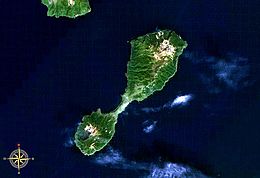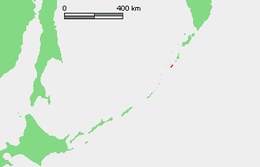Shiashkotan
This article includes a list of general references, but it lacks sufficient corresponding inline citations. (March 2012) |
Native name: Шиашкотан 捨子古丹島 | |
|---|---|
 Landsat view of Shiashkotan Island | |
 | |
| Geography | |
| Location | Sea of Okhotsk |
| Coordinates | 48°49′N 154°6′E / 48.817°N 154.100°E |
| Archipelago | Kuril Islands |
| Area | 122 km2 (47 sq mi) |
| Highest elevation | 944 m (3097 ft) |
| Highest point | Pik Sinarka |
| Administration | |
Russia | |
| Demographics | |
| Population | 0 |
| Ethnic groups | Ainu (formerly) |

Shiashkotan (Russian: Шиашкотан) (Japanese: 捨子古丹島; Shasukotan-tō) is an uninhabited volcanic island near the center of the Kuril Islands chain in the Sea of Okhotsk in the northwest Pacific Ocean, separated from Ekarma by the Ekarma Strait. Its name is derived from the Ainu language, from “Konbu village”.

Geology
[edit]Shiashkotan is roughly dumbbell-shaped, formed by two volcanic islands joined together by a narrow landspit. The island has a total length of 25 kilometres (16 mi) with a width ranging from 9 kilometres (5.6 mi) at its widest point to 0.9 kilometres (0.56 mi) at its narrowest, and an area of 122 square kilometres (47 sq mi).[1] Both ends of the island are complex stratovolcanos, and landing is practical only on the sandy isthmus.
- Pik Sinarka (Russian: влк. Синарка; Japanese: 黒岳; Kurodake), which rises to 934 m (3,064 ft) above sea level occupies the northern end of the island, and is the island’s highest point. Historical eruptions have occurred at Sinarka during 1825–1750, 1846, 1855, and the last and largest from 1872 to 1878. To the east from this volcano is located interesting geothermal field - North-Western solfatara field with more than 100 fumaroles and several hot, geyser-like springs which erupt water up to 1.5 m high.
- Pik Kuntomintar -(Russian: влк.Китаио; Japanese: 北硫黄岳; Kitaiō-dake), occupies the southern end of the island. A central cone fills a 4-4.5 kilometer diameter caldera, and there is a second caldera on the west side which is breached to the west. The only known postglacial activity of Kuntomintar is continuous fulmarole activity near the east wall of the inner caldera and a nearby hot sulfur spring.
History
[edit]Shiashkotan was inhabited by the Ainu, who subsisted off of hunting and fishing, at the time of European contact. The island appears on an official map dated 1644, showing the feudal territories of the Matsumae Domain in Edo period Japan; these holdings were confirmed by the Tokugawa shogunate in 1715.
Later claimed by the Empire of Russia, sovereignty passed to Russia under the terms of the 1855 Treaty of Shimoda. During anvolcanic eruption in 1872, Russian authorities recorded that 13 inhabitants died. When the Kuril Islands were returned to the Empire of Japan, per the 1875 Treaty of Saint Petersburg, no inhabitants remained on Shiashkotan, as they moved north to Russian Kamchatka.
The Japanese administered the island as part of Shimushu District of Nemuro Subprefecture of Hokkaidō. In 1893, a settlement was attempted by nine members of the Chishima Protective Society, led by Gunji Shigetada; however, when a ship called on the island a year later, five of the colonists had already died, and the remaining four were critically ill with beri-beri.
After World War II, the island came under the control of the Soviet Union, and is now administered as part of the Sakhalin Oblast of the Russian Federation.
See also
[edit]Notes
[edit]- ^ "International Kuril Island Project(IKIP)". University of Washington Fish Collection or the respective authors.
References
[edit]- "Sinarka". Global Volcanism Program. Smithsonian Institution. Retrieved 2021-06-25.
- "Kuntomintar". Global Volcanism Program. Smithsonian Institution. Retrieved 2021-06-25.
Further reading
[edit]- Gorshkov, G. S. Volcanism and the Upper Mantle Investigations in the Kurile Island Arc. Monographs in geoscience. New York: Plenum Press, 1970. ISBN 0-306-30407-4
- Krasheninnikov, Stepan Petrovich, and James Greive. The History of Kamtschatka and the Kurilski Islands, with the Countries Adjacent. Chicago: Quadrangle Books, 1963.
- Rees, David. The Soviet Seizure of the Kuriles. New York: Praeger, 1985. ISBN 0-03-002552-4
- Takahashi, Hideki, and Masahiro Ōhara. Biodiversity and Biogeography of the Kuril Islands and Sakhalin. Bulletin of the Hokkaido University Museum, no. 2-. Sapporo, Japan: Hokkaido University Museum, 2004.
External links
[edit]- "Oceandots". Archived from the original on December 23, 2010. Retrieved May 25, 2010.
